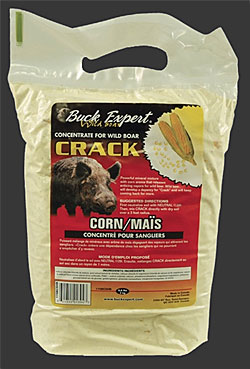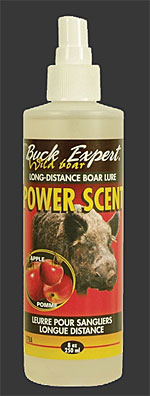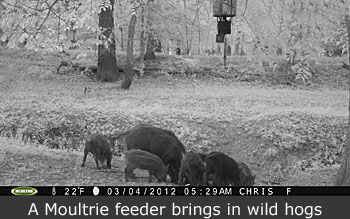
A military tactic as old as warfare itself, the ambush combines concealment and surprise to overwhelm an unsuspecting enemy. Applying the ambush to hog hunting can give you a big tactical advantage.
But how to set up such an ambush?
In the battlefield, you create the appearance of something your target values to lure them in.. The same applies when hunting hogs, so baiting becomes a key tactic.
While the feral hog has relatively poor eyesight, his or her nose is highly adapted and extremely sensitive. A wild hog’s nose is at least the equal of a deer’s, and some hunters swear it’s even better. Any tactical hunter who’s had a hog scent him, and immediately pound the ground at a dead run, knows all too well that hogs have great snouts.
While hogs count on this fine sense of smell to ID their next meal or you, it can also be their demise. As hog hunting’s continued to grow in popularity, a number of hog baits have been developed to take advantage of this biological reality. One of the top lines of hog baits and scents on the market today are made by Buck Expert of Canada, which are distributed by Muskie Moose LLC of Fort Kent, Maine. Dave Kelso is the vice president of Muskie Moose, and notes that the Buck Expert line has been popular among European hog hunters for years.
“The European boar hunters are very, very discriminating,” says Kelso. “Price is not an issue to them. They do demand, though, that everything be thoroughly tested and proven before they’ll buy such products.”
So several years back, the research and development team at Buck Expert actually bought a number of European boars and began testing their baits and attractants on them. Kelso was living in Texas at the time, and he tried out the baits on local feral pigs, too. The results were impressive.
“The baits went over great on those Texas pigs,” Kelso remembers. “Especially the Corn Crack. They loved it!” Muskie Moose offers the full line of Buck Expert hog baits and attractants, including the aforementioned Corn Crack and Fruity Crack. Tests in Europe showed that boars came back to sites baited with Corn and Fruity Crack several times a day.

Buck Expert also produces several Power Scents to spray onto existing baits or nearby vegetation. The smells can and will bring in hogs from hundreds of yards away if not more. Kelso notes that the Buck Expert synthetic boar and sow urines are very effective, too. The synthetic urines fool hogs into thinking that other pigs were there first, a hog’s version of the “all clear!” sign.
Currently, Muskie Moose pro staffers in New York State are testing Buck Expert baits on local feral hog populations.
“They’re using trail cameras on the bait sites, and on trails to and from the sites,” says Kelso. “They’re finding the same results they’ve found in Germany, Sweden, and Turkey. Once the hogs find these baits, they keep coming back and back!”
One option for presenting bait is to simply toss it on the ground. A better option is a good game feeder, which can distribute baits over specific, pre-set time periods, to bring in game on a regular basis.
Moultrie Feeders, of Alabaster, Alabama, is among the country’s top producers of game feeders. Deer hunters are Moultire’s best customers, and they like the fact that Moultrie feeders can be set to distribute bait at pre-determined times over the course of a day. In recent years, says Mike Mattly, Moultrie’s director of public relations, more and more hog hunters are using Moultrie feeders.
“Many hunters that are baiting for hogs use a hanging feeder instead of a tripod feeder,” Mattly notes. “Many times, big hogs will rub on the legs of a tripod feeder and either bend them or knock the feeder over. Moultrie has a variety of hanging feeders such as our 30-gallon Pro Magnum Hanging feeder and our 6.5-gallon Pro Hunter Hanging.”
 Moultrie’s sister company, Code Blue, also introduced three liquid hog attractants this year, plus Tusk Taker, a powder attractant that can be used by itself—though hog hunters tell Mattly they have found good success adding it to corn.
Moultrie’s sister company, Code Blue, also introduced three liquid hog attractants this year, plus Tusk Taker, a powder attractant that can be used by itself—though hog hunters tell Mattly they have found good success adding it to corn.
To set up a new bait site, Mattly recommends first scattering several gallons of shelled corn or other bait over the ground, then pouring a gallon of liquid attractant over this bait.
“The aroma of the liquid attractant will help lure the hogs to the new feeder site,” Mattly explains. “The liquid attractants will seep into the soil, which will keep the smell for a few weeks.”
Once the hogs have found the site, then set up your feeder.
“I would set the feeder [to distribute bait] for just two times a day, which corresponds with the times that you can be in the field. Hogs travel best when the weather is cool, so early morning and late evening often work the best.”
Feral hogs like routines, and will keep coming back to feeding areas as long as forage is available. So look for trails they use traveling to and from your baiting area. This will clue you into the general directions from which they approach your bait. Find good cover and concealment, know your ranges and optimum fields of fire, and get ready to ambush some pigs!
Want to know how to maximize your take on the marching line of hogs who fall for your bait? Read Multi Hog Tactical Engagements: How to Shoot the Most Hogs in a Line.
On the Web:
Muskie Moose, hog and boar products:
http://muskiemoose.com/online-store.html?page=shop.browse&category_id=8
Moultrie Feeders: http://www.moultriefeeders.com/

